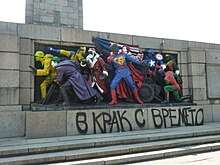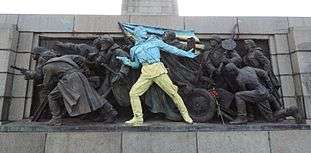Monument to the Soviet Army, Sofia
The Monument to the Soviet Army (Bulgarian: Паметник на Съветската армия, Pametnik na Savetskata armia) is a monument located in Sofia, the capital of Bulgaria. There is a large park around the statue and the surrounding areas. It is a popular place where many young people gather. The monument is located on Tsar Osvoboditel Boulevard, near Orlov Most and the Sofia University. It portrays a soldier from the Soviet Army as a freedom fighter, surrounded by a Bulgarian woman, holding her baby, and a Bulgarian man. There are other, secondary sculptural composition parts of the memorial complex around the main monument, like the group of soldiers which were used as a canvas by political artists. The monument was built in 1954 on the occasion of the 10th anniversary of the liberation by the Soviet Army, which is the Russian interpretation of the complex Military history of Bulgaria during World War II.
Painting of the Monument
2011: Popart comics composition

On June 17, 2011 the monument was painted overnight by a group of anonymous artists who call themselves Destructive Creation[1] and who "dressed" the Soviet Army soldiers as the American popular culture characters: Superman, Joker, Robin, Captain America, Ronald McDonald, Santa Claus, Wolverine, The Mask, and Wonder Woman. A caption was painted underneath which translates as "Abreast with the Times" (in Bulgarian "V krak s vremeto", literally "In pace with time").[2][3]
The paint was removed three days later, in the late hours of June 20, 2011, though later it was declared that it was during the next morning. The event was widely covered by the international media,[4][5][6][7] the at the beginning unknown artists were even being compared to Banksy and called "Banksy of Bulgaria".[8] It has provoked serious pro and anti-Russian discussion in the Bulgarian society.[9] Meanwhile, the Minister of Culture Vezhdi Rashidov called the composition as being an act of vandalism.
The story was filmed in the short documentary In Step With The Time directed by Anton Partalev[10] and includes anonymous interviews of the artists of Destructive Creation and various representatives of pro-Russian organizations in Bulgaria. The film won the second prize in the 2013 festiwal IN OUT (In Out Festival) in Poland. [11]
The painting can be seen as an act of Guerrilla communication for the creation of political consciousness. The monument is a place that delivers an explicit massage of the distribution of power [12] and the Superheroes work like a metaphor for the American way of life transferred by the costumes used like a code.[13] The painting showed the state of affairs in Bulgaria, split between the traditional relationship to the Soviet Union and the modern influence of the western Capitalism.
2012: Anti-ACTA
The monument again was used as a ground of artistic expression and social stance when on February 10, 2012 the soldiers of it were given Anonymous masks of Guy Fawkes, the photo of this was spread in Sofia and Bulgaria as an invitation to anti-ACTA protests held on February 11, 2012 in Bulgaria and Europe.[14]
Other
Further, the monument was used as a ground for protest for Pussy Riot arrest when on August 17, 2012 was photographed with Pussy Riot masks.
On February 1, 2013 during the national day for the commemoration of the victims of communism three of the figures of the monument were painted in white, red and green, the colours of the Bulgarian national flag.
2013: Apology for Prague '68
On 21 August 2013 unknown artists painted the monument in pink in honor of the anniversary of the Prague spring.[15] There was an inscription both in Bulgarian and in Czech which read "Bulgaria apologises".[16] The pink color is a reference to the painting of The Monument to Soviet Tank Crews in Prague by David Černý in 1991. On 22 August, Russia officially demands for sanctions for those responsible over the desecration of the monument and to take immediate measures so that this does not happen in the future. Foreign Minister Kristian Vigenin asks not to dramatize the painting and states that "Bulgaria has international commitments to maintain these monuments. Desecration of a monument is something that should not happen. I think that it should not cause much extreme reactions on this issue, because the institutions in Bulgaria took immediate measures"

2014: "Glory to Ukraine" and "Hands off Ukraine"
On 23 February 2014, the monument was once more painted by unknown perpetrators, this time the statue of one of the soldiers and the flag above it were painted in the national colours of Ukraine. The phrase "Glory to Ukraine" was written in Ukrainian on the monument, as well as an obscene reference to Russian President Vladimir Putin who was called "Kaputin" (from the German kaput, which means broken). The act was in support of the 2014 Ukrainian Revolution.[17] The same day a photo of the painted monument became Best of the day in Euronews with the title: "Bulgaria:" Glory to Ukraine. "[18]
On February 24, the Ministry of Foreign Affairs of Russia expressed outrage saying that "With the feeling of deep resentment in Russia was greeted with news of yet another case of vandalism directed against the Soviet Army monument in the center of the capital of Bulgaria, Sofia during the night of February 23". The Russian Ministry sent a protest note to the Ministry of Foreign Affairs of Bulgaria with a request to "conduct a thorough investigation of this hooligan incident and to accuse those guilty of such an unlawful conduct and also take appropriate measures to bring the memorial back to its normal state."
On March 2, the monument again awakes painted with an inscription defending Ukraine, this time as a reaction to the invasion of Russian troops of the Peninsula of Crimea. The inscription reads "Hands off Ukraine" and crosses out the dedication "for the liberator Soviet Army from the grateful Bulgarian people."
On April 12 one of the statues was painted in the colours of the Polish flag, with another one of the statues standing right behind being painted with the Ukrainian colours. Under the soldiers there is an inscription remembering about the Katyn massacre.
Movement for the removal of the monument
Among right-wing supporters in Bulgaria the movement for removal or demolition of the monument is very strong while at the opposite side hold the Russophiles who insist on keeping it. It has a special place as a gathering (evenings) place of skaters, ravers, rasta and other subcultural groups around it who feel its atmosphere somewhat surrealistic or unreal, between the tension of pro and anti- groups and the natural occupants of the place the monument pop-art events are being brought with its unique for the Bulgarian urban art place.
During the event of 2011 several politicians used the attention to promote the removal of the monument. On June 29 a hearing was scheduled in Sofia municipality, however opinions were split and there were not enough votes to support the move and approve the matter for debates.[19]
References
- "Destructive Creation". destructivecreation.com. Retrieved 2015-06-30.
- (in Bulgarian) Photogallery, Dnevnik, June 18, 2011
- Russian embassy irate over pop art on Sofia monument, AFP, Jun 18, 2011
- "Bulgaria's Soviet army monument gets superhero makeover". Retrieved 2015-07-01.
- "Moving with the times". CNN iReport. Retrieved 2015-07-01.
- "Sofia, i soldati del monumento diventano supereroi - Repubblica.it". Retrieved 2015-07-01.
- "Statuile care compun Monumentul Armatei Sovietice din Sofia au fost pictate cu Superman, Mos Craciun si Ronald McDonald". Retrieved 2015-07-01.
- "Banksy of Bulgaria • Urban Art Core". Urban Art Core. Retrieved 2016-02-07.
- "Russia not amused at Red Army statue re-invented as Superman and friends | World news". The Guardian. 2011-06-22. Retrieved 2017-08-11.
- inoutfest2011 (2013-04-24), Anton Partalev - In Step With The Time, retrieved 2016-02-07
- "Laznia Centre for Contemporary Art – IN OUT FESTIVAL 2013 - AWARDS". laznia.pl. Retrieved 2017-08-11.
- autonome a.f.r.i.k.a. gruppe, Luther Blisset, Sonja Bünzels (2001). Handbuch der Kommunikationsguerrilla. Göttingen. pp. 36–37. ISBN 3935936044.
- Coogan, Peter (2006). Superhero. The secret origin of a genre. Austin. pp. 14–15.
- Sofia awakes with a Monument of the Anonymous army (in Bulgarian), bnews, February 11, 2012
- "Bulgaria appologizes - monument of soviet army painted in pink, Prague 68, pink tank David Cerni". CNN iReport. Retrieved 2015-07-01.
- "On 21 August 2013 unknown artists painted the monument in pink in honour of the anniversary of the Prague spring. There was an inscription in Bulgarian and Czech which read "Bulgaria apologises"". The Guardian. Guardian News and Media Limited. Retrieved 2013-08-24.
- "Soviet Army Monument in Sofia Painted in Ukraine Colors". Novinite. Sofia News Agency. 2014-02-23. Retrieved 2014-02-24.
- "Bulgaria: "Glory to Ukraine"". www.euronews.com. Retrieved 2015-07-01.
- "Вестник "ДУМА" - ДУМИ МНОГО, ДУМА Е ЕДНА | Паметникът на Съветската армия разцепи ГЕРБ (Pametnikăt na Săvetskata armija razcepi GERB)". duma.bg. Retrieved 2017-08-11.
External links
| Wikimedia Commons has media related to Monument to the Soviet Army, Sofia. |
- 3D panorama picture of the popart animation composition
- More pictures of the monument
- The Politics of Conservation - #ДАНСing and Romancing the Soviet Army Monument in Sofia
- Present Struggles with the Heroes of the Soviet Past. ‘Alyosha’ Monuments in Tallinn, Vienna, Plovdiv, and the Post-Communist Space (for a further reading about monuments and their significance)